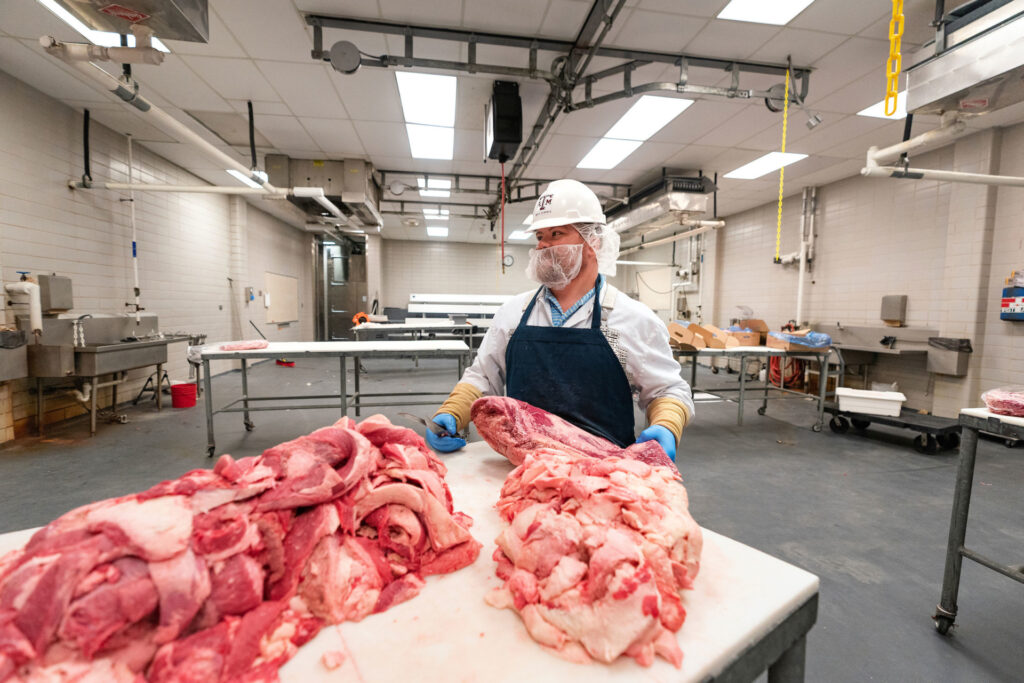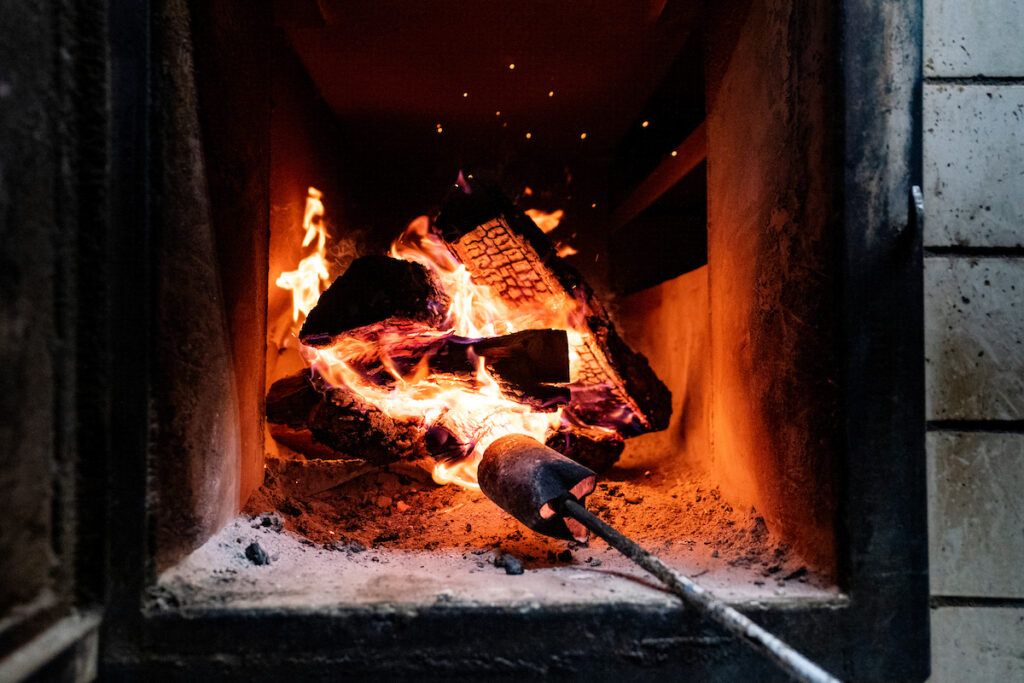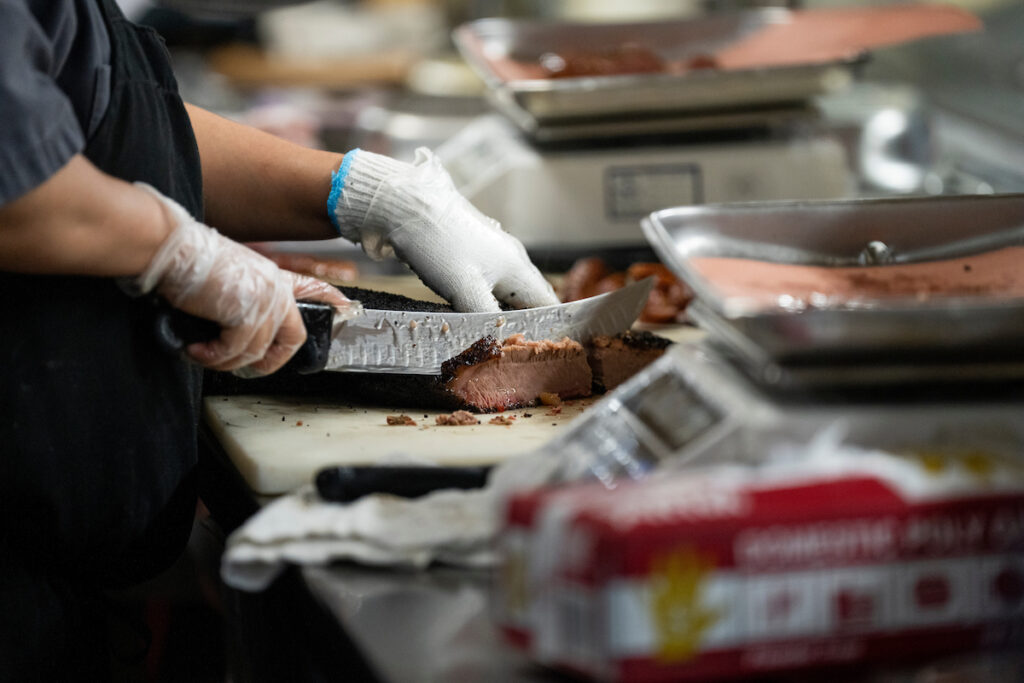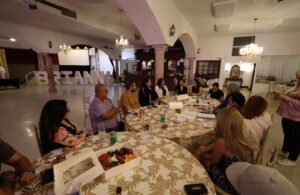- La Feria Community Holds Succesful Business Mixer Event
- Little Nashville to Take Place in Downtown Mercedes
- Lions Basketball Captures District Gold
- La Feria ISD Students Compete in Regional Chess Tournament
- Lions End First Half of 32-4A on a High Note
- La Feria ISD Held Another Successful Parent Conference
- Strong Appearance for Lions at Hidalgo Power Meet
- LFECHS Students Get to Meet Local Actress
- Students Participate in Marine Biology Camp
- Two LFECHS Students Qualify for All-State Band
The Science Behind Texas Barbecue
- Updated: June 11, 2022
Texas A&M AgriLife elevates the barbecue industry through meat science teaching, research and outreach
Written by Adam Russell
As a proud third-generation pitmaster, Bryan Bracewell ’98 has a passion for Texas barbecue that is steeped in family tradition. Bracewell is the current owner of his family’s business, Southside Market and Barbecue, a barbecue restaurant and market that has served the residents of Elgin since 1882.
It was this passion for barbeque that led him to become a student in Texas A&M University’s College of Agriculture and Life Sciences. He knew as a freshman that his enrollment would teach him even more about meat and how to best prepare it.

“Like any smalltown family business, you do things as they’ve always been done and barbecue was no different for me,” he said. “However, I knew there were things I did not know, and I knew my end goal was to improve our product, and ultimately the experience for our customers.”
The knowledge he gained in the classrooms and labs combined with his experience as a member of the meat judging team and as a student worker in the Rosenthal Meat Science and Technology Center all translated into better products for his family’s business. But he didn’t stop at undergraduate classes, he credits much of his current success as a pitmaster to his attendance and participation in the meat science courses and programming that occurred after he received his Aggie ring.
“All the time I spent at Rosenthal attending the Barbecue Summer Camps and Camp Brisket while being around other pitmasters and participating in the panel discussions had a layering effect,” he said. “I learn something new every time.”
Texas tradition meets meat science
For more than a decade, the meat science program within the Department of Animal Science has provided educational programs and platforms where barbecue enthusiasts and established restaurateurs like Bracewell could learn proven, science-backed barbecue methods identified by meat scientists in Texas A&M AgriLife Research and vetted by top Texas pitmasters.

These programs, which translate the most up-to-date meat science and research, have helped brisket, ribs and other Texas-style barbecue enter a new culinary stratum and what Texas Monthly dubbed the “golden age of Texas barbecue.”
However, Davey Griffin, Ph.D., professor in the Department of Animal Science and Texas A&M AgriLife Extension Service meat specialist, Bryan-College Station, said it was a slow and low-key journey for Texas barbecue to become a destination-dining experience.
To understand the evolution of Texas barbecue, Griffin said, people need to first understand the cuts of meat utilized, including briskets and short ribs in cattle. Before the barbecue boom, these cuts were low-value relative to the carcass makeup.

Rib-eye steaks and beef tenderloins for filets were the most tender and preferred for sear-and-serve dining. Other cuts like the chuck and brisket were tough and typically cubed or ground up and used in other dishes.
Slow-and-low Texas barbecue was born within meat markets and by butchers who prepared these undervalued cuts in ways that created consumer demand, Griffin said.
Bryan Bracewell ’98
Owner of Southside Market and Barbecue
William Moon, the original owner and operator of Southside Market and Barbeque in Elgin, is an example of this origin story. In 1882, Moon raised and processed cattle and swine before refrigeration was available, so he began selling smoked sausage and barbecue to reduce spoilage.
“It was one of those ‘necessity is the mother of invention’ situations where these butchers needed to add value to these cuts,” Griffin said. “They found that with time and the right temperature, you could make an incredibly tender serving, and then other businesses put their own spin on the process and end product.”
Texas barbecue evolution speeds up
Over the past several decades, Texas pitmasters used wood, smoke and spices to enhance flavors and do-it-yourself pit designs to provide hours of consistent low heat to turn tough briskets into tender, savory offerings. Bracewell believes the rapid explosion in Texas barbecue was led by the knowledge and science shared during the meat science programs offered.

“Texas Monthly put Texas barbecue in the spotlight with its Top 50 list, but they didn’t get into how it was done well,” Bracewell said. “The meat science programs really connected the dots on the art of good barbecue and what pitmasters were doing and why. Their goal wasn’t to have carbon copies of already successful pitmasters, rather to teach the principles of meat science in ways that could help anyone make the perfect brisket.”
Griffin, Jeffrey Savell, Ph.D., University Distinguished Professor, Regents Professor and E.M. “Manny” Rosenthal Chairholder in the department, and Ray Riley, Rosenthal Meat Center manager, helped usher a new era in meat- and barbecue-based science. As educators, they created and moderated the barbecue curriculum.
The meat science programs now focused on barbecue began when a Houston food critic approached them to learn the science behind another Texas cultural food icon – fajitas, Griffin said. That inquiry seeded an idea that revolved around ways the Department of Animal Science could celebrate Texas’ food culture, preserve its history and pave a way for its future.
Savell and Riley started in 2009 by introducing future generations of industry professionals – freshmen animal science students – to a university-sponsored ANSC 117 – Texas Barbecue course highlighted by Friday afternoon cookouts. Students learned the how-to spectrum of preparing and barbecuing beef, pork, poultry, lamb, goat and turkeys. They even learned various national and international styles of barbecuing, including Kansas City ribs to Cuban- and Hawaiian-style pork.
Additionally, the students learned proper food safety relating to the various cuts and grades of meat, seasonings, marinades, spices and rubs to the pits, smokers and grills.
“It started as a way to help students transition to college life and add to the campus’s community spirit and culture,” Savell said. “They learn about barbecue, and obviously they love to eat it, but the course creates an environment of camaraderie and sharing, and that spirit carried over into the Barbecue Summer Camp. The purpose continues to be to educate our students about meat in a way that gives them an opportunity to share and receive and for us all to learn from and teach each other.”
Barbecue Summer Camp, Camp Brisket and beyond
The trio of Savell, Riley and Griffin have known each other for decades. Savell and Riley knew each other growing up, and Savell was a meat judging team instructor when Griffin and Riley were student members. Griffin and Riley were two of Savell’s first graduate students after he was hired at the university.
The continuity of their passion in the meat sciences continued by spearheading the development of meat science programs that provided outlets to educate backyard barbecue enthusiasts and culinary entrepreneurs alike.

In 2011, Meat Science and Foodways Texas joined the trio to create the first Barbecue Summer Camp with activities held at the Rosenthal Meat Center and O.D. Butler Animal Science Teaching, Research and Extension Complex.
Barbecue Summer Camp is a three-day course that teaches 50-60 attendees, who are lucky enough to be drawn via lottery, the science behind barbecuing beef, pork and poultry.
The first day is dedicated to wood and smoke and pit design. Students learn by slow-cooking briskets in everything from a multi-rack, cylinder pit to a 22-inch kettle grill. The second day exposes students to the intricacies of pork, from spareribs to whole pigs. Then day three is focused on all thing’s poultry – from preparing, brining and injecting birds to beer-can chicken and spicy drums and wings.

By 2013, the meat science program added Camp Brisket, an intensive two-day dive into the slow-and-low magic behind masterpiece briskets. The experiential learning covers woods, smoke, time and temperature, pit designs and safety, meat grades, how to trim fat to maintain the bark and flavor to how to cut the brisket across the grain, Griffin said.
“Brisket is king in Texas,” Griffin said. “Camp Brisket covers all the elements it takes to make the meat the best it can be.”
Around 20-30 briskets are presented to the class the first night for a taste test. The briskets are Prime, Top Choice, Choice, Select and specialty breeds such as Wagyu. Students are tasked with grading the meats based on taste and structure.
The course features the meat science team along with various superstar Texas barbecue pitmasters like Aaron Franklin, of Franklin Barbecue, Austin, or Tootsie Tomanetz, of Snow’s BBQ, Lexington, and Wayne Mueller, of Louie Mueller Barbecue, Taylor.
Bookmark Your Barbecue Camps
https://bbq.tamu.edu/barbecue-summer-camp/
https://bbq.tamu.edu/camp-brisket/
Greater barbecue experiences
Riley said Barbecue Summer Camp and Camp Brisket represent the cumulative knowledge of more than a decade of interactions and discussions on meat science with Texas pitmasters and backyard barbecue enthusiasts.
“It seems like it all came together at the same time,” Riley said. “We’ve had a lot of pitmasters who have changed the quality of their meat and made little tweaks to their process here and there, and it has translated into even greater consumer experiences.”

Barbecue Summer Camp and Camp Brisket have extended outreach and educational opportunities by participating in barbecue festivals, holding a Texas Barbecue Town Hall meeting that cover much of the standard information about meat cuts, pits, temperatures and time, smoke and wood, and preparation and proper food safety.
Griffin, Savell and Riley are amazed at how far the programs have grown, both in institutional knowledge as well as demand. But they are also keenly aware and appreciative of the effort department personnel, program sponsors, the pitmasters and barbecue community put in to help them elevate the craft of barbecue.
“It’s humbling to take something that is a hobby and make it part of the university’s everyday program and curriculum,” Griffin said. “And then for the program to be wildly successful and in such demand and to get the positive feedback from other barbecue hobbyists and professional pitmasters and be able to celebrate and appreciate their success, it’s just amazing how far it has come.”






